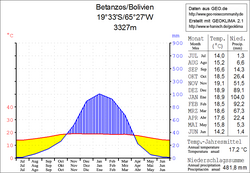Municipio Chaquí
| Municipio Chaquí | ||
|---|---|---|
| Basic data
|
||
| Population (state) - population density |
9910 inhabitants (2012 census) 23 inhabitants / km² |
|
| Post Code | 05-0302 | |
| Telephone code | (+591) | |
| surface | 430 km² | |
| height | 3400 m | |
| Coordinates | 19 ° 36 ′ S , 65 ° 32 ′ W | |
|
|
||
| politics
|
||
| Department | Potosí | |
| province | Province of Cornelio Saavedra | |
| Central place | Chaquí | |
 Location of the Municipio Chaquí in the Department of Potosí |
||
| climate | ||
 Climate diagram Betanzos |
||
The Municipio Chaquí is a district in the Potosí Department in the South American Andean state of Bolivia .
Location in the vicinity
The municipality Chaquí is one of three municipalities in the province of Cornelio Saavedra . It borders the province of Tomás Frías to the west, the province of José María Linares to the south and southeast , and the municipality of Betanzos to the north and northeast . It stretches for about 50 kilometers in north-south and east-west directions.
The central place of the municipality is the village Chaquí with 793 inhabitants ( 2012 census ) in the northwest half of the district.
geography
The municipality of Chaquí is located in the western valleys of the Bolivian Cordillera Central and is only separated from the Altiplano further to the west by the Cordillera del Kari Kari , behind whose mountain ridge in the west lies the city of Potosí , capital of the department. The climate of the region is characterized by a time of day climate in which the temperature fluctuations during the day are more pronounced than during the year.
The annual average temperature is 15 ° C (see also Betanzo's climate diagram) and fluctuates over the course of the year between 12 ° C in June / July and 17 ° C from November to January. The annual precipitation is almost 500 mm and has a clear dry season from April to October, with monthly values in part well below 25 mm, and a short period of humidity from December to February with monthly precipitation of around 100 mm.
population
The population of the Municipio Chaquí has increased by about a tenth over the past two decades:
- 1992 : 9,070 inhabitants ( census )
- 2001 : 9,644 inhabitants (census)
- 2012 : 9,910 inhabitants (update)
The population density of the municipality in the last census of 2012 was 23 inhabitants / km², the proportion of the urban population was 0 percent, the proportion of the population under 15 years of age in 2001 was 43 percent.
The literacy rate among those over 19 is 56 percent, 75 percent for men and 41 percent for women. The most important idiom with a share of 81 percent is Quechua . 83 percent of the population are Catholic, 15 percent Protestant. ( 1992 )
The life expectancy of newborns is 64 years. 84 percent of the population have no access to electricity, 92 percent live without sanitary facilities. ( 2001 )
Due to the historically evolved population distribution, the region has a high proportion of Quechua population, in the municipality of Chaquí 89.1 percent of the population speak the Quechua language.
politics
Results of the elections for the municipal council ( concejales del municipio ) in the regional elections on April 4, 2010:
| Eligible voters | be right | valid | MAS -IPSP | AAOQ | AS | COPA | ||
|---|---|---|---|---|---|---|---|---|
| 4,298 | 3,477 | 2,186 | 1,348 | 394 | 224 | 220 | ||
| 100% | 62.9% | 61.7% | 18.0% | 10.2% | 10.1% |
structure
The municipality is divided into the following two cantons ( cantones ):
- 05-0302-01 Canton Chaquí - 91 localities - 8,911 inhabitants ( 2012 census )
- 05-0302-02 Canton Coipasi - 16 towns - 999 inhabitants
Localities in the municipality of Chaquí
- Coipasi Canton
- El Palomar 288 pop - Coipasi 199 pop .
Individual evidence
- ↑ Instituto Nacional de Estadística (INE) 1992
- ^ Instituto Nacional de Estadística (INE) 2001
- ↑ Instituto Nacional de Estadística (INE) 2012 ( Memento of the original of July 22, 2011 in the Internet Archive ) Info: The archive link has been inserted automatically and has not yet been checked. Please check the original and archive link according to the instructions and then remove this notice.
- ↑ INE social data 2001 (PDF; 5.5 MB)
- ↑ Acta de computo Nacional Electoral Departamentales, Municipales y Regional 2010
Web links
- Municipio Chaquí - general maps No. 50302
- Municipio Chaquí - detailed map and population data (PDF; 456 kB) ( Spanish )
- Department Potosí - social data of the municipalities (PDF 5.23 MB) ( Spanish )
